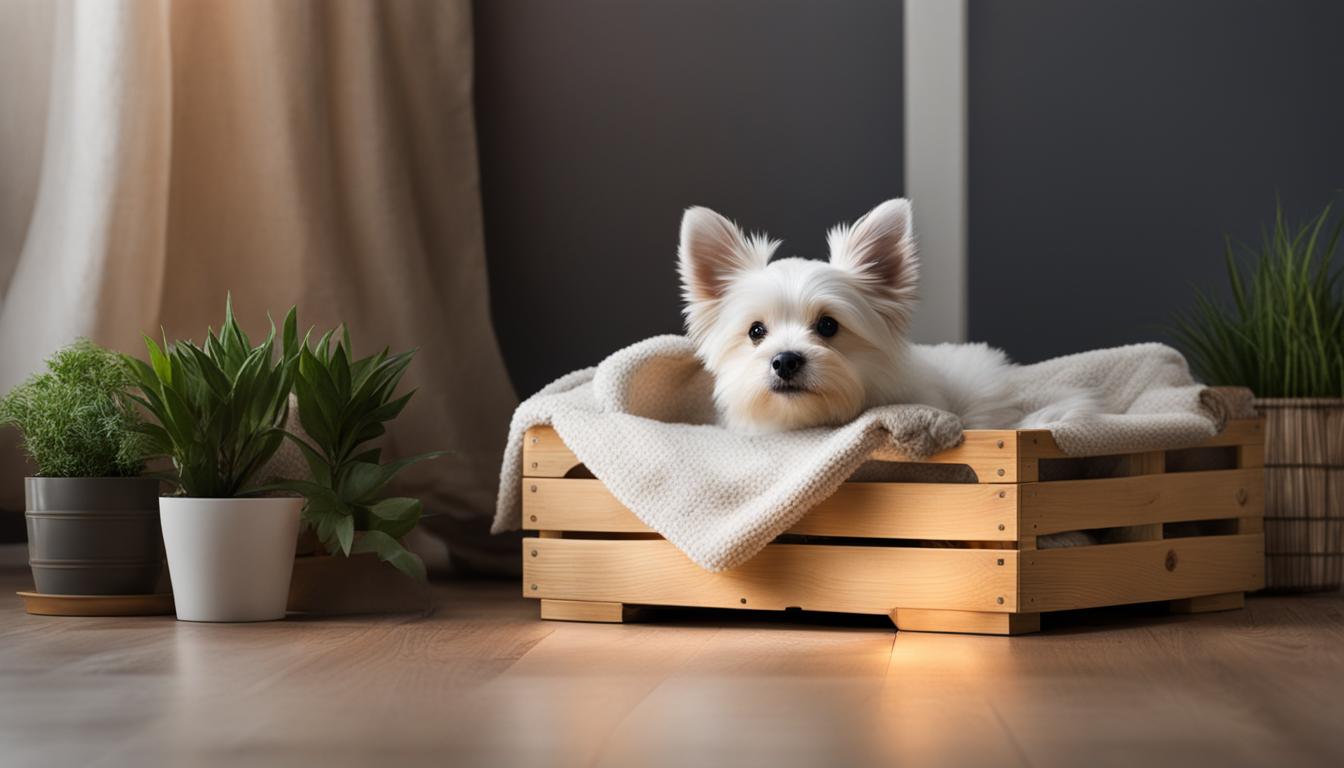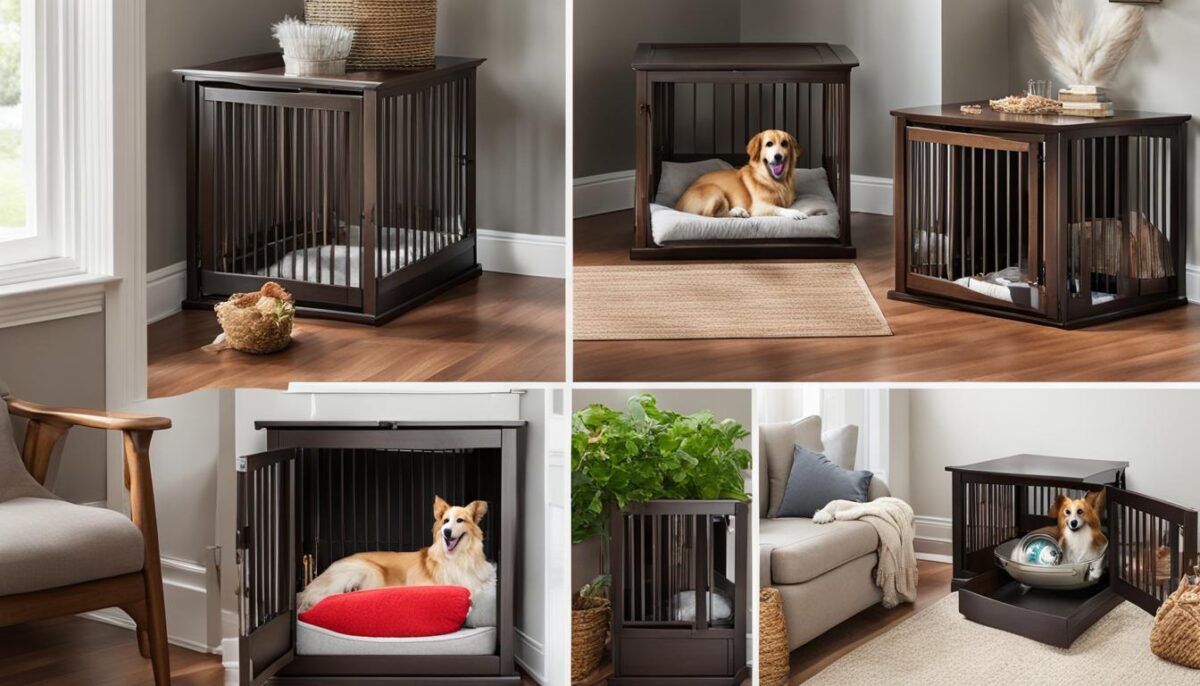You might think of a crate as just a cage, but for your rescue dog, it can be a special home inside your home. When you crate train your rescue puppy, you’re giving them their own safe dog space. This is a place they can relax and feel cozy. Many rescue dogs like having a crate because it lets them have a dog’s personal space that’s all theirs.
Learning to use a crate might seem tricky at first, but don’t worry. We’ll go through the crate training steps together. You want your dog to think of its crate as a comfortable crate, kind of like you think about your favorite chair or spot on the couch.
Key Takeaways
- A crate is like a small room for your dog where they can feel safe.
- It’s important to find the right size crate so your dog can stand up and turn around.
- Introduce the crate slowly to make sure it’s a happy place for your puppy.
- Use treats and meals to make the crate feel like a fun hangout spot.
- Practice with the crate every day so your dog gets used to it.
Understanding the Importance of Crate Training
When you bring home a rescue dog, you might hear about crate training. Crate training is like giving your dog its own room. This room, or secure den, is a safe place where your dog can relax and feel comfortable. It’s also a helpful tool for you. Behavior management gets easier because your dog can learn when it’s time to rest and when it’s time to play.
For your dog’s comfort, their crate can be a cozy spot. Just like you love your bedroom, dogs enjoy having a space that’s all theirs. This private area means they can take a break from noise or people whenever they like.
Let’s say there’s an emergency, like a bad storm or you need to travel. If your dog knows their crate, emergency preparation becomes simpler. Your dog will be okay staying in their den, and that means less stress for everyone. Remember, things like heartworm treatment might mean your dog needs to rest a lot. When they’re used to a crate, it’s easier to keep them calm and safe while they get better.
Before you adopt a rescue dog, shelters will tell you some rules or adoption requirements. Often, knowing how to stay in a crate is one of these rules. Rescues want to make sure the dog will be okay in all sorts of different places, like in a new home or when they go to the vet.
“A crate is more than just a cage, it’s a haven where your dog can retreat and feel secure.”
Even though crates are great, they might not work for every dog. If a dog feels really scared or tries to hurt itself, a crate might not be the best choice. These dogs need other kinds of care to feel safe.
- Provides a secure den for chilling out
- Helps with behavior management and learning house rules
- Offers a cozy spot for your dog’s comfort
- Keeps your dog safe during emergency preparation
- Important for rest during heartworm treatment
- Meets some rescue dog adoption requirements
Learning about crate training helps you understand why it’s good for your dog. It takes time and patience, but it can make a big difference for your furry friend!
How to Crate Train a Rescue Dog
Before you begin, picking the right stuff for your furry friend’s new home is super important. You’ll need a crate that’s just the right size – not too big and not too little. Finding the perfect crate can be like a game – you want to find one that lets your dog stand up, turn around, and lie down comfortably. Think about a crate that’s cozy and tough at the same time so that your buddy has a safe space that feels like their own.
Gathering the Right Materials
Starting off, the crate selection is key. Think about getting a strong crate, maybe even one of those cool collapsible metal pens if you plan to travel or move it around often. Inside, lay down some comfortable bedding that invites your dog to nap and relax. For drinks on the go, an attachable water bowl is super handy and for fun, let’s not forget those tough, indestructible toys that keep on giving!
Introducing Your Dog to the Crate
The next step is to help your dog get to know their crate. You want them to think of it as their special hangout spot. Place the crate in the family room where you all chill, and keep the door open so your dog can wander in and out. Use some tasty treats to make it exciting and build a positive association with their new digs. If your dog is feeling shy, that’s okay! Keep encouraging them with kind words and yummy treats until they feel brave enough to go inside and explore.
Feeding Meals Inside the Crate
Mealtime can also be crate time! Start by having your dog’s food bowl near the crate door. Then, each time they’re eating, sneak the bowl a bit further back into the crate. Soon enough, they’ll be dining inside their crate like it’s their personal diner. This will make them feel all good about their crate. Oh, and remember to toss in some treat dispensing toys to keep mealtime fun.
Increasing Time Spent in the Crate
Now, for the grand finale, it’s time to up the ante on how long your dog hangs out in their crate. Start with just a few minutes when you’re at home, so they know you’re close by. Then you can play a game of hide-and-seek where you sneak away for a bit each time. As your dog gets better at this game, you can start leaving them in their crate at bedtime or when you step out. Remember to give lots of praise and set up a comfy space for a quiet resting spot. If your dog whines, be super chill and give them time to realize it’s all okay – it’s just their special time in their home away from home.
Remember, taking it slow is the key to crate training. It’s all about making the crate a super fun and comfy place that your dog loves to hang out in. With patience and lots of treats, you’ll have your rescue pal loving their crate in no time!
Conclusion: Embracing Patience and Persistence in Crate Training
Teaching your rescue dog to love their crate is not a race. It’s about being kind and steady. You want your dog to feel happy and safe, and that means going slow and keeping things fun! Every dog is different, like people, and some learn faster than others. For the best results, do the same steps in the same order every time. Make sure each step is fun for your dog, without any scary feelings attached. This way, crate training becomes a game they always win.
Remember, your love and time are the best tools for helping your dog learn. When challenges come up, and they might, stay calm and patient. Your gentle guidance tells your dog that the crate is a good place, even when you’re not around. Managing any worries they have will help a lot. Plus, having a good crate routine will make everyday life better for both you and your dog. It’s worth every minute you spend on it.
Crate training works best when you are patient and keep going even when it’s hard. Imagine how proud you will feel when your dog starts going into the crate all by themselves, ready for a rest or a nap. That shows you did a great job! Every step you take teaches your dog to trust and love you more. So, stick with it and look forward to the days of a happy dog and a cozy crate home.
FAQ
What are the first steps in crate training a rescue dog?
Start by selecting the right crate for your rescue dog, considering size and durability. Place the crate in a common area of your home and let your dog explore it at their own pace. Encouraging them with treats or toys can help form a positive association with the crate.
How can a crate provide a safe space for my rescue dog?
A crate acts as a secure den for your dog, offering them a personal area where they can relax and feel protected. It serves as a behavioral management tool and a safe haven during stressful situations like emergencies or moving to a new home.
Why is it important to know a dog’s prior history with crate training?
Understanding if your rescue dog has been previously crate trained or has had negative experiences with crating is crucial. This knowledge will help you tailor your approach, anticipating how they might react to crate training and adjusting your methods accordingly.
What materials do I need for effective crate training?
You’ll need a sturdy crate that’s appropriately sized for your dog, along with comfortable bedding that can withstand chewing. Accessories like attachable water bowls and indestructible toys can also enhance the crate experience, making it a more enjoyable space for your dog.
How do I introduce my dog to their crate?
Introduce your dog to the crate gradually. Keep the crate door open and encourage exploration with treats. Make sure the crate remains a happy place, and never force your dog to enter. Use positive reinforcement to build a pleasant relationship between your dog and their crate.
What role does feeding play in crate training?
Feeding your dog meals inside the crate can help build a positive connection with it. Begin by placing their food near the entrance and progressively moving it farther back. Eventually, you can close the crate door while they eat, creating a routine that fosters comfort with the crate.
How long should I leave my dog in the crate?
Start with short periods while you are at home to get your dog used to being in the crate. Gradually extend the time, working up to leaving them crated when you’re out and during the night. Always ensure your dog has a comfy bed and safe toys to play with inside the crate.
How can I deal with my dog’s whining when they are in the crate?
If your dog whines in the crate, offer calm reassurance without letting them out, as this could reinforce the behavior. Make sure they’ve had enough exercise and don’t need to relieve themselves. With patience, your dog should learn that whining doesn’t lead to being let out.
When is crate training not recommended for a dog?
Crate training is not suitable for dogs with severe anxiety, dementia, or tendencies toward self-harm. For these dogs, a crate could increase stress and potentially lead to injury, so alternative methods should be considered for ensuring their safety and comfort.
What should I do if my dog is resistant to crate training?
If your dog shows resistance to crate training, slow down the process and ensure every interaction with the crate is positive. Review your training approach, potentially seeking advice from a professional trainer. Patience and consistency are key in overcoming this challenge.

